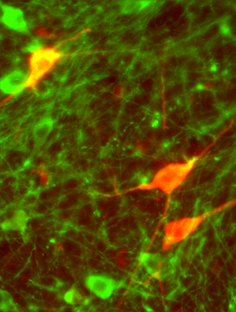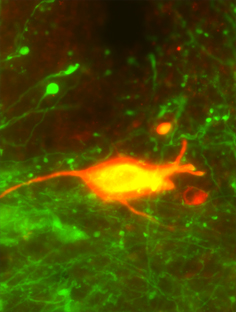Research

Biocytin-filled neurons co-labeled with tyrosine hydroxylase in the VTA

Biocytin-filled neuron co-labeled with tyrosine hydroxylase in the VTA

The potent nervous system effects of nicotine are clearly evidenced by the widespread use of tobacco products. In addition to reinforcing smoking behavior, nicotine is also reported to have analgesic, anxiolytic and memory-enhancing properties. Many CNS neurons express membrane receptors that bind nicotine with high affinity, and these receptors are ultimately responsible for the behavioral effects of nicotine. The normal activator of these receptors is the neurotransmitter acetylcholine, and there are several nicotinic acetylcholine receptors (nAChR) subtypes expressed in the CNS. Determination of the nAChR subtypes that underlie the various physiological effects of nicotine may lead to the identification of new methods for treating neurological disorders, in addition to the obvious benefit of potentially helping people quit smoking.
To assess the reinforcing or addictive properties of nicotine, we are primarily testing the effects of the drug on ventral tegmental area dopamine system. All drugs of abuse are known to enhance dopamine release from midbrain reward centers and this is a crucial step in the reinforcement of drug-taking behavior. We have found that, similar to the role of these receptors in other CNS regions, presynaptic nAChRs can enhance excitatory inputs to midbrain dopamine neurons. A long standing question in the field is how a single nicotine exposure can induce increases in dopamine release that last for hours, while the nicotinic receptors undergo desensitization in seconds. Our recent results indicate that presynaptic nAChR activation can contribute to the induction of long-term potentiation (LTP) of excitatory transmission at this synapse. LTP is believed to be an important step in memory formation in other brain regions. The idea that nicotine can induce a 'memory trace' within the reward center may explain why this substance is such a strong motivator.
- H.D. Mansvelder & D.S. McGehee. (2000) Long term potentiation of excitatory inputs to brain reward areas by nicotine. Neuron 27: 349-357.
- H.D. Mansvelder, J.R. Keath & D.S. McGehee. (2002) Synaptic mechanisms underlie nicotine-induced excitability of brain reward areas. Neuron 33 (6): 905-919.
- Z.M. Fagen, R. Mitchum, P. Vezina, D.S. McGehee. (2007) Enhanced nicotinic receptor function and drug abuse vulnerability. J. Neurosci. 27(33):8771-8.
- H.D. Mansvelder, Z.M. Fagen, B. Chang, R. Mitchum, D.S. McGehee. (2007) Bupropion inhibits the cellular effects of nicotine in the ventral tegmental area. Biochem Pharmacol. 74(8):1283-91.
- J.R. Keath, M.P. Iacoviello, L.E. Barrett, H.D. Mansvelder, D.S. McGehee. (2007) Differential modulation by nicotine of Substantia Nigra versus Ventral Tegmental Area dopamine neurons. J. Neurophysiol. 98(6):3388-96.
- D. Mao, D.S. McGehee (2009) Nicotine and Behavioral Sensitization. J Mol Neurosci. (In Press)





